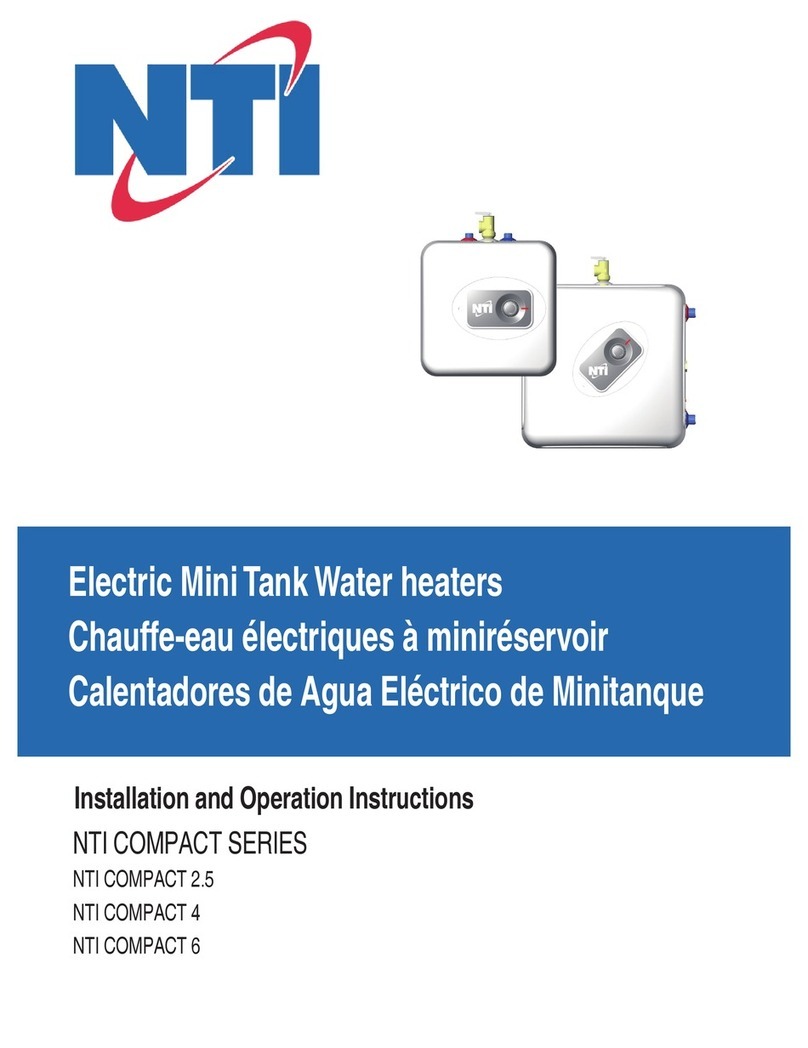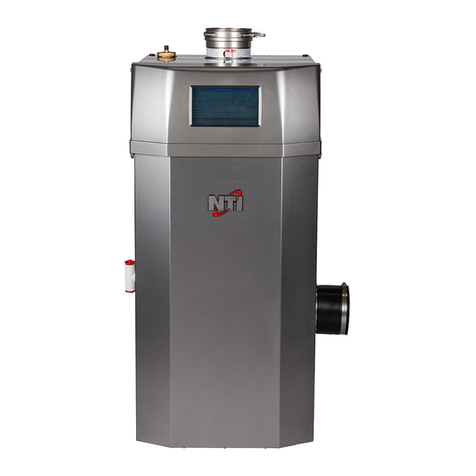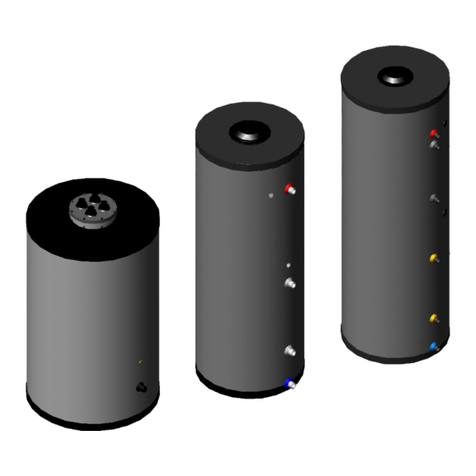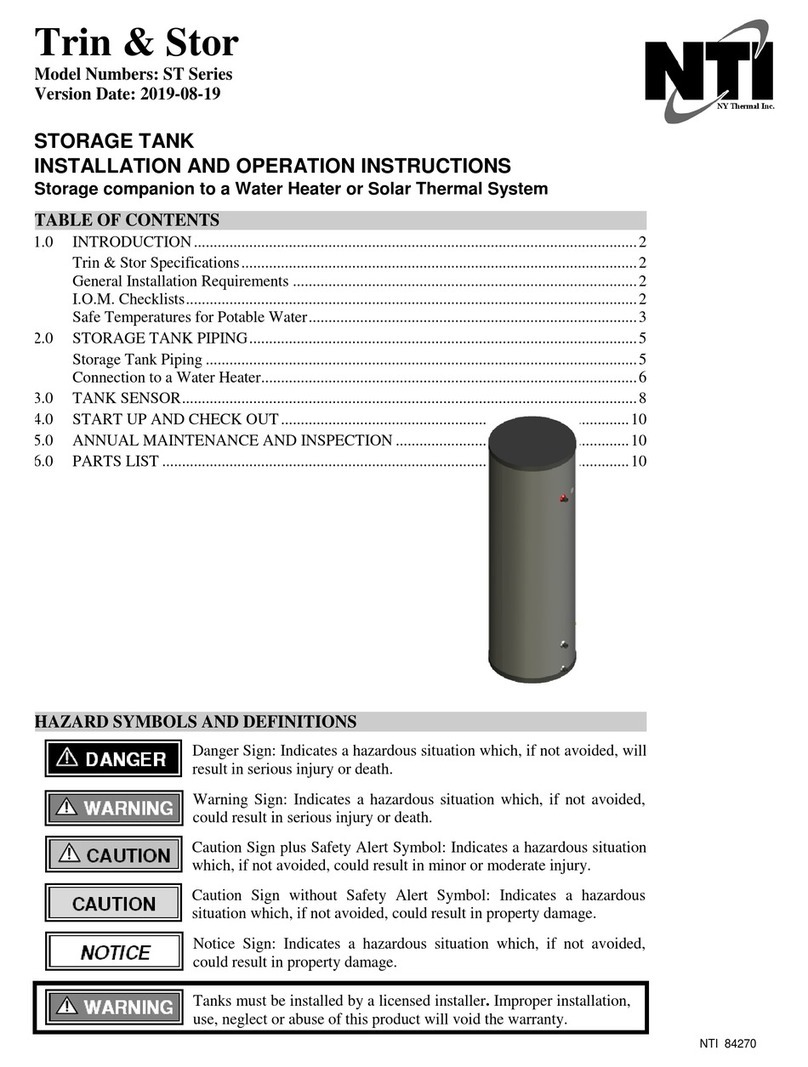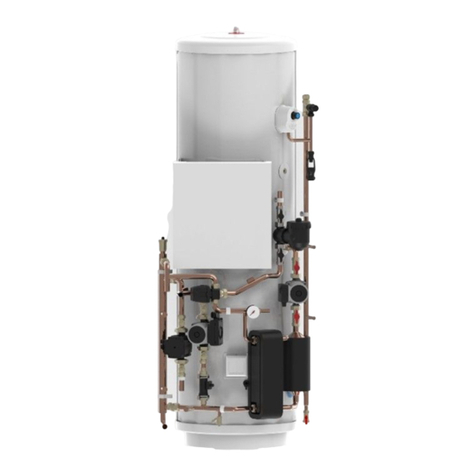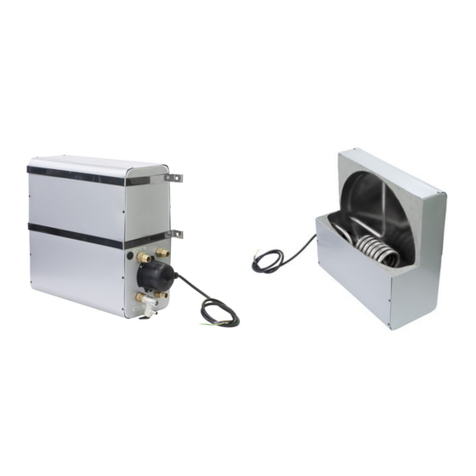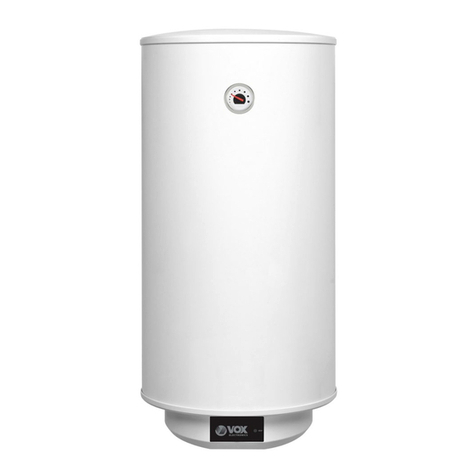NTI Trin & Stor S Series User manual

Trin & Stor
Model Numbers: S & S20W Series
Version Date: 2021-09-01
30 Stonegate Dr.
Saint John, NB
E2H 0A4 Canada
INDIRECT WATER HEATERS
INSTALLATION AND OPERATION INSTRUCTIONS
To be installed in conjunction with an NTI Boiler
TABLE OF CONTENTS
1.0 INTRODUCTION................................................................................................................2
Trin & Stor Specifications....................................................................................................2
I.O.M. Checklists..................................................................................................................3
2.0 WATER HEATER PIPING .................................................................................................7
Domestic Side Piping ...........................................................................................................8
Boiler System Piping............................................................................................................9
3.0 TANK SENSOR.................................................................................................................15
4.0 START UP AND CHECK OUT........................................................................................17
5.0 ANNUAL MAINTENANCE AND INSPECTION...........................................................17
6.0 PARTS LIST ......................................................................................................................18
HAZARD SYMBOLS AND DEFINITIONS
Danger Sign: Indicates a hazardous situation which, if not avoided, will
result in serious injury or death.
Warning Sign: Indicates a hazardous situation which, if not avoided,
could result in serious injury or death.
Caution Sign plus Safety Alert Symbol: Indicates a hazardous situation
which, if not avoided, could result in minor or moderate injury.
Caution Sign without Safety Alert Symbol: Indicates a hazardous
situation which, if not avoided, could result in property damage.
Notice Sign: Indicates a hazardous situation which, if not avoided,
could result in property damage.
This Indirect Water Heater must be installed by a licensed and trained
Heating Technician, or the Warranty is Void. Failure to properly
install this unit may result in property damage, serious injury to occupants, or possibly death.
NTI 84230
S20W
S Series

Trin & Stor │Installation and Operation Instructions Indirect Water Heaters
2
1.0 INTRODUCTION
Trin & Stor Specifications
NTI’s Indirect Water Heaters: "S" Series consists of a high-performance stainless-steel tank and heat exchanger
coil.
Table 1-1 Indirect Water Heater Specifications
Model
Storage
Capacity
USG (L)
Type
Weight (lbs)
Hour 1 Recovery 3
(Gal @ Outlet Temp)
Boiler
Output
(MBH)
Coil Flow
Rate
(GPM)
Coil
Drop
(Feet)
Continuous Rate
(GPH @ Outlet Temp)
Empty
Filled1
140F
115F
140F
115F
S20W
21 (80)
Stainless
Steel
Indirect
85
260
290
445
232
10
4.5
273
428
S40
40 (150)
71
485
213
319
155
10
1.3
181
287
S50
53 (200)
90
655
251
372
180
10
1.6
211
332
S65
66 (250)
104
672
327
484
234
15
3.5
275
432
S80
79 (300)
115
995
378
559
268
15
4.7
314
495
S120
119 (450)
157
1275
485
711
333
20
9.4
389
615
Notes:
1Ensure the location chosen for the tank is capable of supporting the tank when filled with water.
2Refer to Table 1-2 for a list of considerations when selecting a location for the tank.
3Hour 1 Recovery based on 50oF inlet water temperature and 200oF boiler water outlet temperature.
Table 1-2 Indirect Water Heater Characteristics
S Series
S20W
Tank 1
stainless steel
stainless steel
Coil
stainless steel
stainless steel
Insulation
EPS foam
EPS foam
Jacket
Grey Plastic
20ga Painted Steel
Recommended Service Clearances
top
12"
top
12”
connection side
12"
sides
4”
bottom
0”
bottom
24”
Restrictions
MAWP
150 psi
MAWP
150 psi
Max tank temp
190oF
Max tank temp
190oF
Max boiler temp
210oF
Max boiler temp
210oF
Notes:
1Water used in the tank must meet the water chemistry limits specified in Table 2-1. Levels outside the limits may corrode the
tank and shorten its life resulting in damage to tanks and voiding the warranty.
Table 1-3 Trin & Stor System Contents
Part No.
Description
S40
S50
S65
S80
S20W
S120
84156
Temperature and Pressure Relief Valve, 150psi
1
1
1
1
1
1
84632
Tank Sensor
1
1
1
1
1
1
87312
Sensor Clip
0
0
0
0
1
0
87313
Tank Sensor
0
0
0
0
1
0
87085
Mixing Valve, 3/4" Union
0
0
0
0
1
0
Parts and Service - See Table 1-3 for a list of components included with each tank. For inside sales or technical
Warranty Registration - Trin & Stor tanks have a Limited Lifetime Warranty. A separate Warranty Card is
shipped with the tank and packaged with the manual kit. The warranty card explains the coverage options, terms
and conditions, actions required to register the warranty, and what to do in the case of a warranty service problem.

Indirect Water Heaters Installation and Operation Instructions │Trin & Stor
3
I.O.M. Checklists
The various Installation, Operation and Maintenance (IOM) Checklists contained in this manual are meant to be
read in conjunction with the details, drawings, and safety information to ensure a complete and proper installation.
Pre-Installation Checklist
Inspection and Preparation
1. Remove packaging. Inspect for damage during shipping.
2. Verify package contents as per Table 1-3.
3. Review system specifications and characteristics.
4. Read the Water Chemistry and Warranty requirements.
Locating the Tank
1. Solid foundation, dry location, near boiler.
2. Leave room to service water heater and controls.
3. Sufficient room for boiler piping and servicing boiler.
4. Area free of flammable liquids or combustible vapors.
5. Install where leaks will not damage property.
6. Locate in room where temperature never drops below 50oF (10oC).
Building Interface Requirements
Penetrations through which piping, or wiring is passed shall not:
1. Reduce or impair the function or structural integrity of the enclosure.
2. Work shall be performed in accordance with applicable standards, ordinances, and local codes.
Water Damage Protection
1. If the area around the tank location is susceptible to water damage, install a catch pan c/w drain under the tank.
2. Make provisions to protect the surrounding area from water damage should a leak occur from the tank, fitting
connections, or relief valve.
General Installation Requirements
Generalized instruction and procedures cannot anticipate all situations. For this reason, only a qualified installer
should perform the installation.
Users Responsibility –This manufacturer anticipates the proper installation and care in use of the product. As
with any hot water system, there is a risk of property damage and personal injury inherent in the use. NTI
cannot supervise the installation and therefore makes it a specific condition for the warranty that the customer
will supervise the installation and use of the product to be sure they are performed in accordance with the
instructions and I.O.M. Checklists in this manual. It is the User’s responsibility to maintain the appliance by
having it inspected on an annual basis, serviced as required, and to use the product for the purpose it was
intended.
Installers Responsibility –A qualified installer is a licensed person who has appropriate training and a working
knowledge of the applicable codes, regulations, tools, equipment, and methods necessary to install an indirect
water heater. The Installer assumes all responsibility for a safe installation and that it meets the requirements
of this document, as well as National and local codes.
Consider the following when selecting a location for the Indirect Water Heater: all tanks will eventually leak at
some unpredictable time, so take precautions and use a catch pan with a drain beneath the water heater to contain
potential leaks or install the tank in a location not susceptible to water damage. Do not install near a wood stove
where excessive heat could melt the water heater’s plastic jacket. Boiler supply piping, floor drain locations,
relief valve discharge will also need to be considered before selecting a location.
Scope of Instruction - This document pertains to the correct installation and operation
of the NTI Trin & Stor Indirect Water Heater line. This manual DOES NOT provide
installation instructions for heating system boilers; therefore, installers must refer to the
boiler manufacturers instructions for boiler installation procedures.

Trin & Stor │Installation and Operation Instructions Indirect Water Heaters
4
Emergency Situation - Should the water heater be subject to flood, fire or other
damaging conditions turn the power and water to the heater off. DO NOT place water
heater in operation again until it has been thoroughly checked by qualified service
personnel.
Raised Tank - Support the entire tank bottom with ¾" plywood (min) if elevating
off the floor with blocks.
Code Requirements - The installation of your NTI Trin & Stor Indirect Water Heater
must conform to the requirements in this manual, as well as National and local codes.
Safe Location - DO NOT install indirect water heater close to any high temperature
appliances or wood stoves as the water heater jacket is combustible. DO NOT install
where there is a risk of property damage in the event of an eventual leak at some
unpredictable time.
Annual Service - Failure to have the Indirect Water Heater properly serviced and
inspected on a regular basis by a qualified service technician may result in property
damage, serious injury or death.
Flammable Vapors - DO NOT install this appliance in any location where gasoline,
flammable vapors or air-born contaminants are likely to be present.
Warranty Requirements - Improper installation, use, neglect, or abuse of this product
may not only jeopardize the safe operation of this appliance but also void the warranty.
Read and understand this manual prior to proceeding with the installation of the Trin &
Stor Indirect Water Heater and the potential hazards associated with DHW. Failure to
follow the instructions outlined in this document will result in property damage, serious
injury or death.
Safe Temperatures for Potable Water
Two factors used to determine safe hot water temperatures are Legionella and scalding. Potable water needs to
be stored at temperatures hot enough to limit the growth of Legionella yet be cool enough to prevent scalding.
Since both hazards present a potential risk to the user, they must be monitored and controlled. Table 1-4
indicates how water temperature affects Legionella bacteria and contributes to scald injury. Use of a thermostatic
mixing valve in the indirect water heater plumbing system can help protect against both hazards. By storing
potable water at higher temperatures, bacteria growth is controlled, while still providing high temperature water
for dishwasher applications and low temperature water for bathing. Before proceeding, read the following
carefully and take all necessary precautions to avoid potential illness and/or injury that can result from
Legionella or scalding hazards.
Legionella Hazard –This bacteria is naturally occurring in surface water and ponds. It
can also be found in man-made water systems around the world such as water storage
tanks, water distribution systems, fountains, hot tubs, humidification systems, refrigeration systems and grocery
produce misters. Health authorities agree that Legionella bacteria most often enter the lungs due to aspiration
when contaminated water spray is breathed in as opposed to ingesting drinking water contaminated with the
bacteria. Typical illnesses attributed to Legionella include flue like symptoms (Pontiac Fever) and a potentially
fatal type of pneumonia (Legionnaires’ disease). Failure to follow instructions may result in illness or death.
Contributing Factors to Legionella - Experts acknowledge that Legionella is an identified risk in most water
systems. Although eradicating Legionella is improbable, precautions can be taken to control and monitor
conditions that promote bacteria growth. According to the World Health Organization (WHO); American
Society of Heating, Refrigeration, and Air-conditioning Engineers (ASHRAE); Canada Safety Council (CSC);
and Centers for Disease Control (CDC), contributing factors to the growth of Legionella in potable water
systems include:

Indirect Water Heaters Installation and Operation Instructions │Trin & Stor
5
•Minerals and nutrients present in the source water and systems materials
•Stagnation or low flow characteristic of dead ends in distribution piping systems and storage tanks
•Scale, corrosion, and bio film
•Tepid water in cold water lines
•Water storage temperatures optimal for bacteria growth
•Chlorine concentration
Scald Hazard - Hotter water increases the risk of scald injury. There is a hot water scald
potential if the storage tank thermostat is set too high. Before changing the temperature
setting on the tank thermostat, refer to the thermostat manufacturers recommended settings. Failure to follow
these instructions may result in serious injury or death.
A scald injury can occur when hot steam or liquid makes contact with one or more layers
of skin. Scald severity (degree of burn) is directly impacted by exposure time and
temperature. Refer to Table 1-4. The following basic precautions are common sense:
•Young children and elderly adults burn more quickly and should use cooler water.
•Never leave a child alone while drawing water in a bathtub.
•Test the water temperature before bathing or showering.
•Turn cold water on first, then add hot water until the temperature is comfortable.
Thermostatic Mixing Valve - When the system requires water at temperatures higher
than required for other uses, such as high temperature applications typically greater than
46oC (115oF), a means such as a thermostatic mixing valve shall be installed to temper
the water for those uses in order to reduce scald hazard potential. Anit-scald devices such as a thermostatic
mixing valve allows potable water to be stored at a higher temperature to limit bacteria growth and allows water
at the tap to be delivered at a lower temperature to prevent scalds. Failure to follow these instructions may result
in serious injury or death.
S20W must always be installed with a thermostat mixing valve to protect against
scalding, regardless of the temperature setpoint at the boiler. Failure to properly install
and set the mixing valve will result in serious injury or death.
Legislation and Guidelines - At the time this document was written, standards and
guidelines regulating the prevention of Legionella in the United States and Canada were
mostly voluntary. The American Society of Heating, Refrigerating and Air-Conditioning Engineers, Inc.
(ASHRAE) is currently in the process of converting its guideline entitled "Minimizing the Risk of Legionellosis
Associated with Building Water Systems" (ASHRAE Guideline 12-2000) into an official standard. Consult with
your local authorities as to recommended guidelines for controlling Legionella in potable water systems.
Storing water at temperatures >140°F with the use of a thermostat mixing valve may not
be permitted in some States, so check with the applicable authorities having jurisdiction
(AJH). In Canada, recent changes to the National Plumbing Code requires that domestic
hot water be stored at or above 140oF and then mixed down to safe temperatures at the
tank outlet.
General Guidelines - In the absence of a National standard or local codes, the following are general guidelines
for “good practice” on maintaining, monitoring and operating your potable water system:
•Store domestic hot water at temperatures > 61oC (140oF).
•Store and distribute cold water at temperatures below 20oC (68oF).
•System supply for uses other than high temperature applications typically greater than 46oC (115oF) shall be
equipped with a thermostatic mixing valve on the hot water outlet to reduce potential scald hazards.
•Clean aerators and nozzles on water fixtures on a regular basis to reduce scale build-up.
•Clean storage tanks and remove sediment. Flush storage tanks and piping systems regularly for 10-30
minutes at high water temperatures (depending on guidelines used) to rid the system of sediment and scale
that develops, typically in the bottom of storage tanks where water temperature is coolest; and piping runs

Trin & Stor │Installation and Operation Instructions Indirect Water Heaters
6
where water can stagnate.
•Abandoned water lines should be capped off at the distribution main, not at the most convenient place.
•Avoid dead-ends in piping system. If unavoidable, provide a drainage port in these areas at the lowest point
to flush out stagnant water regularly.
•Insulate Domestic Hot Water piping and recirculation lines to R-2.6.
•Insulate the last 5 feet of the cold-water line entering the tank to R-2.6.
•Keep pipe runs as short as possible to avoid unnecessary heat loss.
•Recommend annual water testing of water in your tank and piping system(s) to monitor water conditions.
•Keep a maintenance record of when your indirect water heater and storage tank were cleaned, piping
systems flushed and who did the service work.
Table 1-4 How Water Temperature relates to Legionella and Scald Hazard
Water Temperature 1
Legionella Bacteria 1
Water Temperature 2,5
Exposure Time vs Burn 5
158-176oF
70-80oC
Disinfection range
158oF
70oC
1 second - 2nd or 3rd degree burn
140-149oF
60-65oC
Bacteria die within minutes
140oF
60oC
5 seconds - 2nd or 3rd degree burn
122-131oF
50-55oC
Bacteria die within hours
131oF
55oC
5 seconds - 1st degree burn
68-113oF
20-45oC
Bacteria thrive and multiply
122oF
50oC
1 minute - 1st degree burn
below 68oF
below 20oC
Bacteria is dormant
111oF
44oC
5 hours - 1st degree burn 3,4
Notes:
1 Published by Chartered Institute of Plumbing and Heating Engineering, Databyte series, "Safe Hot Water Temperatures".
2The elderly and small children are susceptible to bad burns at shorter exposure times than listed in this table.
3A thermostatic mixing valve should be installed on DHW storage tanks when outlet temperatures exceed 115oF [46oC].
4Typical water temperature for bathing or showering range between 98-113oF [37-45oC].
5Temperature-Time-Burn Chart published by John Hopkins University, excluding notes.

Indirect Water Heaters Installation and Operation Instructions │Trin & Stor
7
2.0 WATER HEATER PIPING
Failure to follow the instructions provided in this section will void your NTI warranty
and may result in property damage, fire, serious injury or death.
Domestic Side Piping
The various series of NTI Trin & Stor indirect water heaters are dimensioned and connection ports marked in
Figures 2-1 and 2-2. Dimensioned drawings are to be read in conjunction with Table 2-3, 2-4 and 2-5 which
identify the connection type and port size and illustrates typical domestic water piping for a single indirect water
heater. Basic system components are identified in Table 2-2 and their function described in detail below. For
multiple Indirects, pipe the tanks in parallel using equal pipe lengths between each tank and a common tee to
ensure equalized draw.
Energy Efficiency - Although the NTI Trin & Store Indirect Water Heater is an energy-efficient appliance,
insulating long pipe runs can improve the system efficiency by conserving energy and reducing standby losses.
System Preparation - Prior to connecting plumbing to the indirect water heater, flush the entire system to ensure
it is free of impurities that may be harmful to the system or indirect water heater. Check the water composition
of the domestic water supply prior to filling the tank to ensure the water characteristics are within the range
specified in Table 2-1. Water used in the tank must meet the water chemistry limits specified in Table 2-1.
Levels outside the limits may corrode the tank and shorten its life resulting in damage to the tank and voiding
the warranty. If levels are outside the acceptable limits, consult a qualified water treatment expert about
treatment options for domestic water.
Damage to tanks resulting from water chemistry levels outside the ranges specified in
Table 2-1 can cause corrosion, shorten the life of the tank, and will void the warranty.
Table 2-1 Water Chemistry Requirements
Characteristic
"S" series
"S20W" series
Many solder fluxes can severely
corrode stainless steel. Once piping
connections are completed, flush the
water heater by drawing at least three
(3) times the tank’s volume through
the water heater prior to heating
water in the tank. Failure to flush the
tank will void the warranty.
pH
Min
6.0
Min
6.0
Max
8.0
Max
8.0
Chloride (ppm)
Min
0.0
Min
0.0
Max
80.0
Max
80.0
Notes:
1Residual solder flux can corrode stainless steel. Flush tank before heating
the domestic water in the tank or warranty will be void.
System Components - As a minimum, a properly installed system will include the following major components
identified in Table 2-2. It is the responsibility of the installing contractor and system designer to consider all
aspects of a proper system design including compliance with local codes, including additional components
required for prevention of thermal siphoning (i.e., heat traps), isolation valves, drain and purge valves, etc.
Table 2-2 Domestic Side Major Component Checklist
Factory Supplied Components
Field Supplied Components
Indirect Water Heater
System Backflow Preventor2
Relief Valve
DHW (Potable Water) Expansion Tank2,3
Tank Sensor1
Thermostatic (Anti-Scald) Mixing Valve 4
Thermostatic (Anti-Scald) Mixing Valve 4
Drain Valve
Notes:
1All NTI Indirect Water Heaters come standard with a Tank Sensor.
2Check if required by local codes.
3Expansion Tank is mandatory if using a System Backflow Preventor.
4Included with S20W ONLY.

Trin & Stor │Installation and Operation Instructions Indirect Water Heaters
8
Indirect Water Heater - NTI Trin & Stor Indirect Water Heaters are equipped with a single-walled internal heat
exchanger coil. To maintain the efficient and reliable operation of the heat exchanger, and to avoid heat
exchanger failure, it is critical to ensure the rules and guidelines in this section are followed.
Locate the water heater in an area where leakage from the tank or plumbing connections
will not result in water damage to adjacent areas or lower floors. If such a location is
unavoidable, install a suitable catch pan with a drain under the appliance. This
manufacturer is not responsible for any water damage that may occur in connection with
the indirect tank or any of its components.
Temperature and Pressure Relief Valve –NTI Trin & Stor Indirect Water Heaters come standard with a factory
supplied temperature and pressure relief valve sized to ASME specifications and compliant with Standard
ANSI Z21.22•CSA 4.4 Relief Valves for Hot Water Supply Systems. The field installed relief valve and
discharge piping is to be mounted on the Indirect Water Heater in accordance with Figures 2-3 and 2-4 must be
accessible for servicing or replacement. No valve is to be placed between the Relief Valve and the Indirect
Water Heater or Relief Valve and discharge pipe. Install discharge piping as shown in Figures 2-3 and 2-4 in
accordance with Installation Checklist 2-1.
T&P Normal Operation - The relief valve is not intended for constant duty such as
repeated operation due to normal system expansion. If this occurs, correct the situation
by installing a properly sized domestic expansion tank as per the expansion tanks
manufacturer’s instructions.
Location - Do not conceal, plug, or remove the relief valve from its designated point of
installation. Failure to comply may result in property damage, personal injury, or death.
Tank Sensor - designed for installation into the Thermal-Well of the Trin & Stor Indirect Water Heater; the Tank
Sensor provides a temperature reading of the tank to an NTI boiler, eliminating the need for a separate
controller. The Tank Sensor incorporates a UL353 rated thermal cutoff switch designed to open at a
temperature of 90ºC (194ºF). Tank Sensor installation instructions are detailed in Section 3.0.
Drain Valve - The Indirect water heater requires a field supplied drain valve to facilitate emptying the tank for
inspection and servicing. Refer to Tables 2-4 and 2-5 and Figures 2-3 and 2-4 for drain port size and type.
System Backflow Preventor - Check if a backflow preventor (BFP) is required by local codes. Most plumbing
codes require a thermal expansion control device be installed if a backflow preventor, pressure reducing valve
or check valve is installed on a domestic supply line. If a backflow prevention device is used, then an expansion
tank is mandatory (not optional) and must be installed downstream of any device used to control system thermal
expansion. When using multiple indirects, check if a single BFP is required on the domestic supply or if each
tank requires its own backflow preventor and respective expansion tank. See Figures 2-3 and 2-4.
DHW (Potable Water) Expansion Tank - This manufacturer recommends installing an expansion tank in the
domestic hot water system for the purpose of absorbing the increase in water volume caused by rising water
temperature. If required by local codes, the expansion tank must be suitable for use with potable water and be
sized in accordance with the water volume of the system and the firing rate of the boiler connected to the
indirect water heater. Refer to the expansion tank manufacturer’s literature for proper sizing information.
Isolation Valves –Ensure any valves installed between the expansion tank and indirect
tank inlet are left in the OPEN position during normal operation. Failure to follow these
instructions may result in discharge of the Relief Valve and result in property damage or
personal injury.
Thermostatic (Anti-Scald) Mixing Valve - A mixing valve is recommended (mandatory with S20W) on
branches supplying low temperature water to endpoint plumbing fixtures when domestic hot water is stored
above 46°C (115°F).

Indirect Water Heaters Installation and Operation Instructions │Trin & Stor
9
Thermostatic (Anti-Scald) Mixing Valve - When the system requires water at
temperatures higher than 46°C (115°F), a mixing valve shall be installed to temper the
water and reduce the risk of scalding. NOTICE the installation of mixing valve is
mandatory with model S20W. Failure to follow these instructions may result in serious
injury or death.
Boiler System Piping
The NTI Trin & Stor line of high efficiency Indirect Water Heaters are intended to be heated by an external hot
water boiler where hot water supplied from the boiler is connected to ports 4 and 5 on the indirect tank and
circulated through an internal heat exchanger coil in the tank. See Figures 2-4 and 2-5. The tanks are specifically
designed for low temperature applications [<100oC (210oF)] and are NOT intended to be used as a pool heating
system or in conjunction with steam boilers or other high temperature appliances where water temperatures could
potentially exceed 100oC (210oF). Refer to the Installation and Operation Manual included with the boiler for
detailed instructions on connecting boiler system piping to the indirect water heater.
High Temperature Applications - Trin & Stor Indirect Water Heaters are not to be used
for high temperture applications [greater than 100oC (210oF)] or in conjunction with
steam producing systems as this will void the warranty. Failure to follow these
instructions may damage the tank resulting in property damage, serious injury or death.
Installation Checklist
1. Install domestic side pipingas per National and local codes. Refer to Figures 2-3 and 2-4.
2. Do not over tighten brass threads on water supply connectinos.
3. Do not apply heat to the cold-water inlet on the indirect water heater.
4. Mark the water supply for future reference.
5. Install a mixing valve on the hot water outlet of the water heater as shown in Figures 2-3 and 2-4.
6. Install boiler water connections (if used) as per the boiler manufacture’s instructions.
7. Cap (plug) any unused connection ports, such as domestic hot water recirculation.
8. Install T&P relief valve on tank in accordance with local codes and Figures 2-1 through 2-4.
9. Ensure no valve is installed between the relief valve and indirect water heater or discharge pipe.
10. Ensure discharge piping material used is rated to withstand temperatrues up to 250°F (120°C).
11. Direct discharge to a safe area (drain) where hot water or steam will not cause damage or injury.
12. Terminate discharge pipe 6”-12”above the floor. Do not connect discharge pipe directly to a drain.
13. Typical discharge pipe diameter ¾”. Maximum pipe length is 15 feet with 2 or less elbows.
14. Cut discharge end of pipe at a 45° angel to reduce the risk of being blocked or capped.
15. Install drain valve in the location and orientaion shown in Figures 2-3 and 2-4.
16. Verify with local codes if a backflow preventor or thermal expansion control device is required.
17. Install a domestic expasion tank downstream of the backflow preventor (control device).
18. Install the domestic expasion tank on the cold-water supply of the domestic side piping.
19. Flush the tank thoroughly before filling to heat water. Fill heat exchager coild with heating fluid.
20. Insulate the last 5 feet of the cold-water line and all domestic hot water piping to R-2.6.

Trin & Stor │Installation and Operation Instructions Indirect Water Heaters
10
Figure 2-1 Indirect Water Heater Dimensions
Table 2-3 Indirect Water Heater Dimensions
Model
Dimensions (inches)
A
B
C
D
E
F
G
H
I
J
K
S40
56
54 ¾
46 ¾
46 ¾
29 1/8
25 1/8
26 1/8
9 3/8
2 1/8
2 1/8
20 1/8
S50
49
47 ¾
39 ¾
39 3/8
29 5/8
26
27
9 7/8
2
2
23 7/8
S65
70 5/8
69 ¼
60 ¼
60 ¼
32 ½
27 1/8
28 1/8
10 ¼
2
2
21 7/8
S80
70 ¼
69
60 7/8
60
35
29 5/8
30 5/8
10 ¾
2 3/8
2 3/8
23 7/8
S120
-
64 ¾
53 5/8
53 ¼
44 5/8
40 5/8
41 5/8
12 ¼
2 3/8
2 3/8
28 7/8
Table 2-4 Indirect Water Heater Connections
Model
Connection Port Sizes (inches)
T&P RV
Hot Out
Recirc
Boiler In
Boiler Out
A-stat Lw
Cold In
1
2
3
4
5
6
7
S40
¾F
1 M
¾F
1 M
1 M
Well
1 M
S50
¾F
1 M
¾F
1 M
1 M
Well
1 M
S65
¾F
1 M
¾F
1 M
1 M
Well
1 M
S80
¾F
1 ½M
¾ F
1 M
1 M
Well
1 ½M
S120
¾F
1 ½M
¾ F
1 M
1 M
Well
1 ½M
* Connections are NPT unless noted otherwise. All Tank Sensor connections are friction fit immersion wells.

Indirect Water Heaters Installation and Operation Instructions │Trin & Stor
11
Figure 2-2 Indirect Water Heater Dimensions
Table 2-5 Indirect Water Heater Dimensions
Model
Dimensions (inches)
A
B
C
D
E
F
G
H
I
J
K
L
M
N
O
S20W
10 3/8
6 1/8
19
1/2
35 1/2
10 3/8
14
5 3/4
9 3/4
10 3/8
13 1/2
6 1/8
9
13
15
20 7/8

Trin & Stor │Installation and Operation Instructions Indirect Water Heaters
12
Figure 2-3 IWH Domestic Plumbing Schematic

Indirect Water Heaters Installation and Operation Instructions │Trin & Stor
13
Figure 2-4 IWH Domestic Plumbing Schematic

Trin & Stor │Installation and Operation Instructions Indirect Water Heaters
14
Figure 2-5 Wall Mounting Procedure for S20W
Mounting to a Concrete Wall
1. Position the upper wall mounting bracket (NTI P/N 86938) on the
concrete wall. Ensure the bracket is level. Then use the bracket as a
template to mark four (4) drilling holes on the wall - two (2) on
each side of the bracket (shown below).
2. Drill and plug the wall. Then secure the upper mounting bracket
using the provided Fischer S 10x50screws. Ensure the bracket is
level.
3. Install the lower mounting brackets (NTI P/N 86162) on the
S20W. Then hang the S20W on the upper mounting bracket. Ensure
the S20W is level. Then use the lower bracket to mark the lower
bracket drilling holes.
4. Drill and plug the wall and secure the lower mounting bracket
using field provided screws. Then adjust the lower mounting
brackets on the S20W. Ensure the S20W is installed plumb. Tighten
the brackets to the S20W.
Mounting to a Wood Studded Wall
1. Position the upper wall mounting bracket (NTI P/N 86938) on the
wall. Ensure the bracket is level and the drilling holes are on stud.
Then use the bracket as a template to mark four (4) drilling holes on
the wall - two (2) on each side of the bracket (shown below).
2. Then secure the upper mounting bracket using the provided (Fischer
S 10x50) screws and field provided washers for wood mounting.
3. Install the lower mounting bracket (NTI P/N 86162) on the S20W.
Then hang the S20W on the upper mounting bracket. Ensure the S20W
is level. Then use the lower bracket to mark the lower bracket drilling
holes.
4. Secure the lower mounting bracket using field provided screws.
Then adjust the lower mounting brackets on the boiler. Ensure the
S20W is installed plumb. Tighten the brackets to the S20W.

Indirect Water Heaters Installation and Operation Instructions │Trin & Stor
15
3.0 TANK SENSOR
The follow instructions below show how to install the tank sensor. Refer to boiler IOM for wire connections.
The Tank Sensor is NOT compatible with NTI-Trinity Ti and Ts series boilers; when
using a Trin & Stor Indirect Water Heater with one of these boilers, the TPI Control
Thermostat, or other thermostat or aquastat must be used. TPI Control Thermostat
instructions are included with the TPI.
Installation Instructions “S”Series
WIRE TANK SENSOR TO BOILER AND ADJUST BOILER CONTROL SETTINGS –REFER
TO BOILER IOM
LOCATE THERMAL WELL
INSERT TANK SENSOR
(NTI P/N 84632)
SECURE TANK SENSOR
Hook wire retainer to the back of the Thermal-Well rib;
pull to ensure it will not fall-out.
Connect to boiler
using field wiring

Trin & Stor │Installation and Operation Instructions Indirect Water Heaters
16
Installation Instructions S20W
WIRE TANK SENSOR TO BOILER AND ADJUST BOILER CONTROL SETTINGS –REFER
TO BOILER IOM
SECURE TANK SENSOR
Hook wire retainer (NTI P/N 87312)
to the back of the Thermal-Well rib;
pull to ensure it will not fall-out.
Connect to boiler
using field wiring
INSERT TANK SENSOR
(NTI P/N 87313)
LOCATE THERMAL WELL

Indirect Water Heaters Installation and Operation Instructions │Trin & Stor
17
4.0 START UP AND CHECK OUT
Filling the Water Heater
1. Thoroughly flush the water heater so that three (3) times the tank’s volume has been drawn through it.
2. Verify water connections completed.
3. Close drain valve. Open highest hot water faucet.
4. Open cold water inlet valve and fill system.
5. Fill until a steady stream of water flows from the faucet.
6. Close the hot water faucet.
7. Ensure the boiler and domestic piping is free of leaks before proceeding to operational checklist.
Operational Checklist
1. Ensure all electrical connections are made correctly and no high voltage wires are exposed.
2. Verify the Tank Sensor is properly installed and is providing an accurate reading on the boiler display. In lieu
of the Tank Sensor ensure the Thermostat is correctly signaling the boiler to operate.
3. Verify the boiler control is set to deliver the desired DHW temperature.
4. Ensure the tank is filled with water.
5. Ensure that the tank’s heat exchanger coil(s) are filled with water or heat transfer fluid.
6. Ensure piping system is free of leaks and that air has been purged from system.
7. Initiate a call for domestic hot water by opening hot water taps on domestic water fixtures.
8. Verify that the boiler starts when there is a demand for hot water and shuts down when the demand is
satisfied.
9. Verify proper circulator operation and boiler flow rate during a hot water demand. Allow all heating zones to
operate long enough to purge any remaining air from the system.
10. Check for proper operation of relief valve by opening it manually.
11. If T&P relief valve functions continuously during normal thermal expansion, the expansion tank may need to
be upsized.
5.0 ANNUAL MAINTENANCE AND INSPECTION
Inspection Checklist
1. Perform a visual inspection of all valves, drains, and system piping for signs of leaks.
Maintenance Checklist
1. Verify maximum water temperature at hot water fixtures to verify mixing valve temperature settings.
2. Manually operate T&P relief valve by moving lever to open position until hot water is released and allow it to
snap close. If closed relief valve continues to leak, close cold-water inlet, drain tank, and replace relief valve.
3. If T&P relief valve functions continuously during normal thermal expansion, the expansion tank may need to
be upsized.
4. Ensure that boiler system is maintained in accordance with their installation manuals.
5. Check function of field-installed controls, thermostats, and circulators.
6. Check tank PH and chloride levels to determine if water chemistry is within the specified range.
7. Any additional procedures required by local codes.
Draining the Water Heater
1. Disconnect the power supply to the heat source.
2. Close the cold-water supply shut off valve.
3. Allow appliance to cool before servicing to avoid burns.
4. Open the drain valve and divert water in tank to alternate storage location or floor drain.
5. Open highest hot water faucet to allow air to enter the system.

Trin & Stor │Installation and Operation Instructions Indirect Water Heaters
18
6.0 PARTS LIST
Table 6-1 Indirect Water Heater
Item
Part #
Models
Description
1
84156
S Series & S20W
Relief Valve, T&P, ¾", 150 psi
2
84632
S Series
Tank Sensor
3
87312
S20W
Sensor Clip
4
87313
S20W
Tank Sensor
5
87085
S20W
Mixing Valve, 3/4" Union, ASSE 1017 & 1070
Trin & Stor parts available at any stocking wholesaler. Installers needing technical
assistance can contact NTI directly at 1-800-688-2575.

Indirect Water Heaters Installation and Operation Instructions │Trin & Stor
19

Trin & Stor │Installation and Operation Instructions Indirect Water Heaters
20
NTI Boilers Inc. 30 Stonegate Dr. Saint John, NB E2H 0A4 Canada
Technical Assistance: 1-800-688-2575
Website: www.ntiboilers.com
Fax: 1-506-432-1135
This manual suits for next models
6
Table of contents
Other NTI Water Heater manuals
Popular Water Heater manuals by other brands
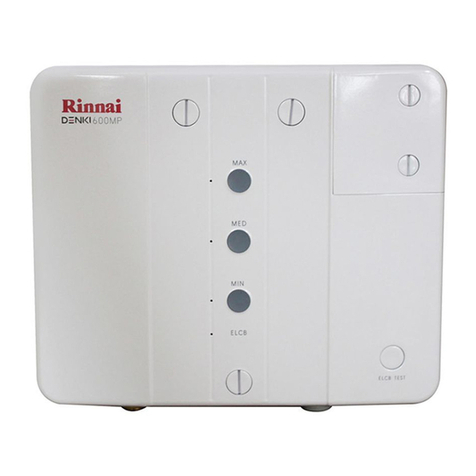
Rinnai
Rinnai NIPPON 600MP manual

andrews
andrews SF61 Technical documentation
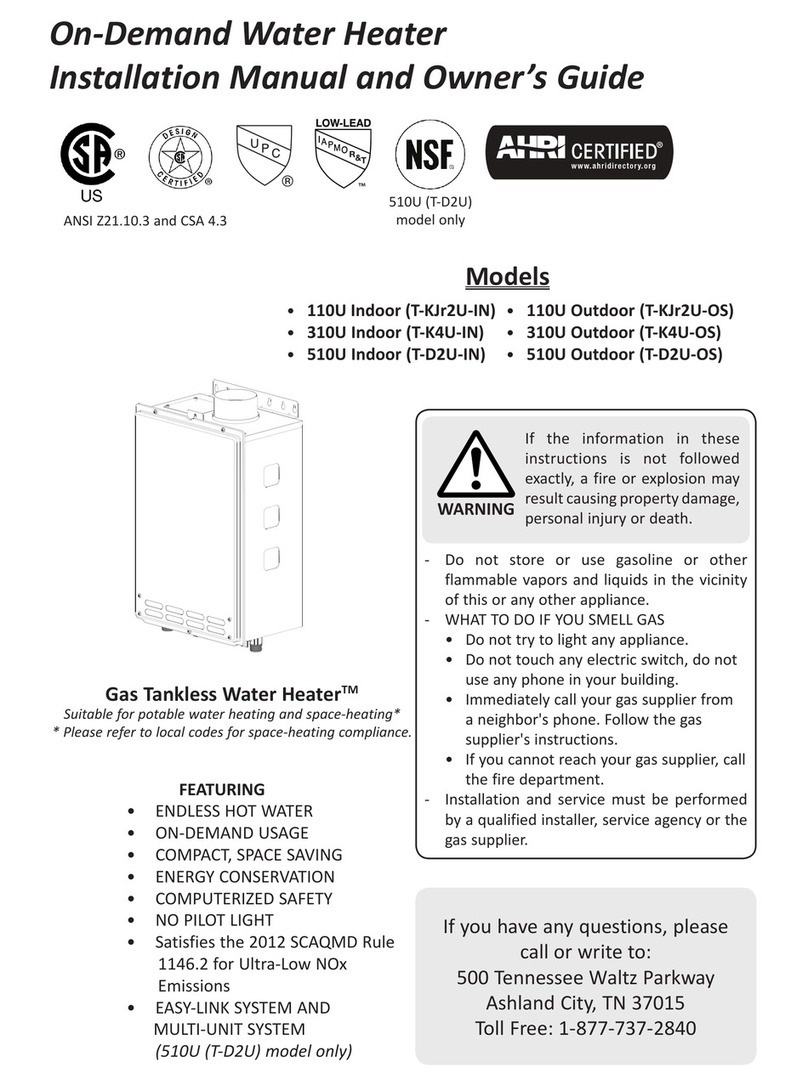
Takagi
Takagi T-K4U-IN Installation manual and owner's guide

PVI
PVI QuickDraw PV500-24 Installation and maintenance manual

Lochinvar
Lochinvar COMMERCIAL GAS WATER HEATERS instruction manual

Regulus
Regulus RGC 120H Installation and operation manual

Truma
Truma AquaGo basic Operating and installation instructions

Noritz
Noritz proTOUGH NR981-SV installation manual

Vetus
Vetus WWS42..B Series Installation instructions and owner's manual
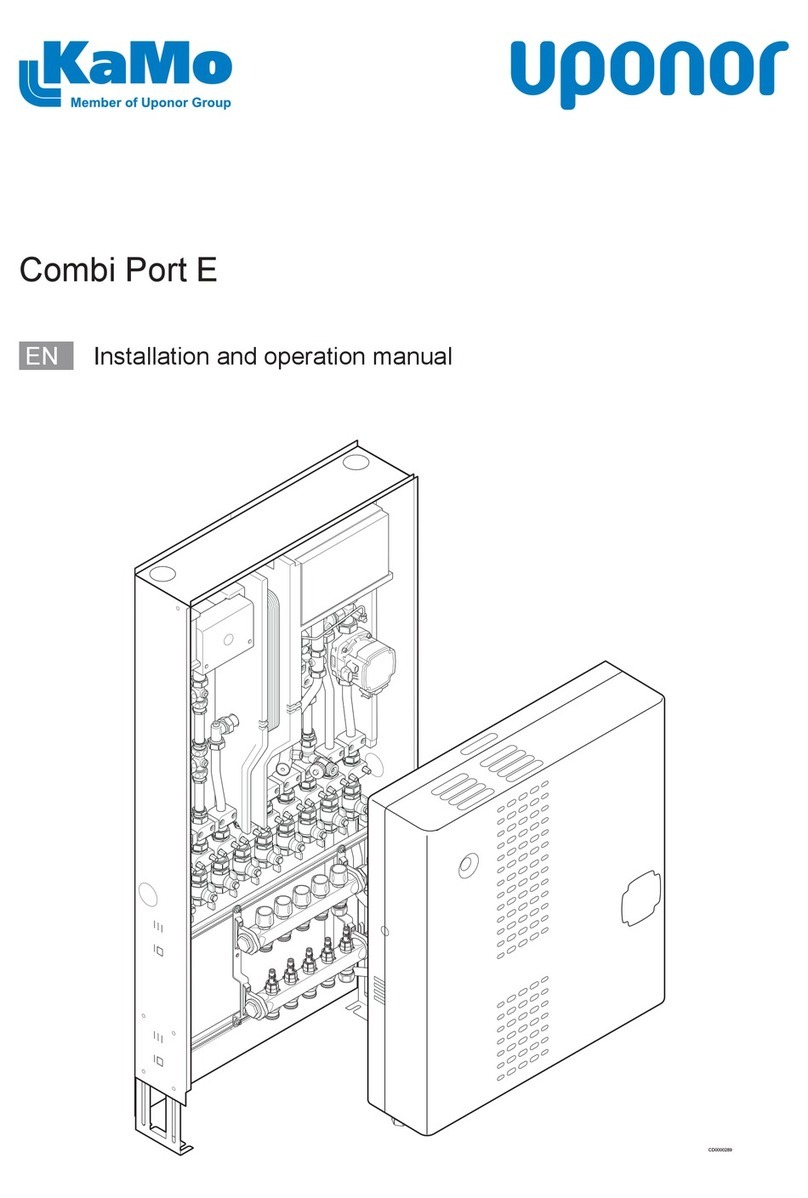
Uponor
Uponor KaMo Combi Port E Installation and operation manual

Bradford White
Bradford White RG250H6N-475 manual
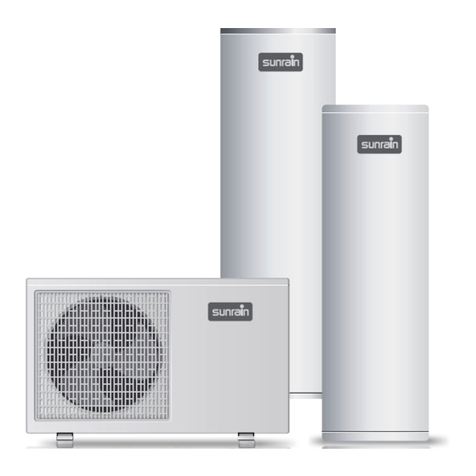
Sunrain
Sunrain KFC-75XTI user guide


